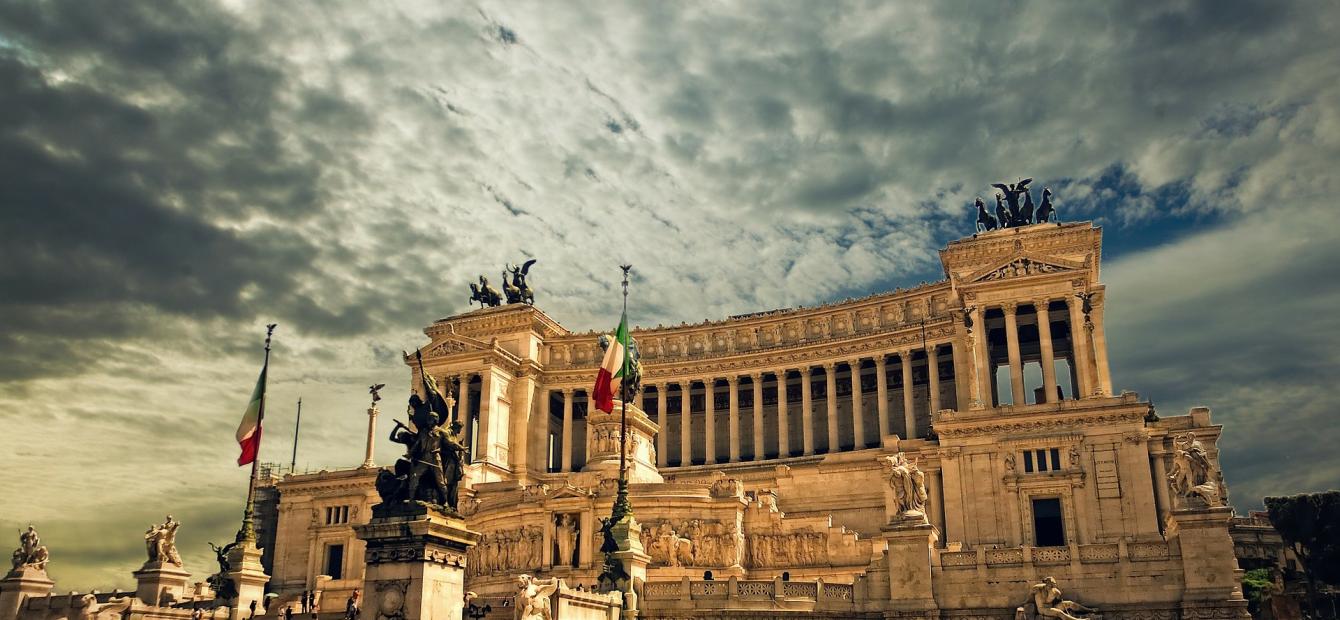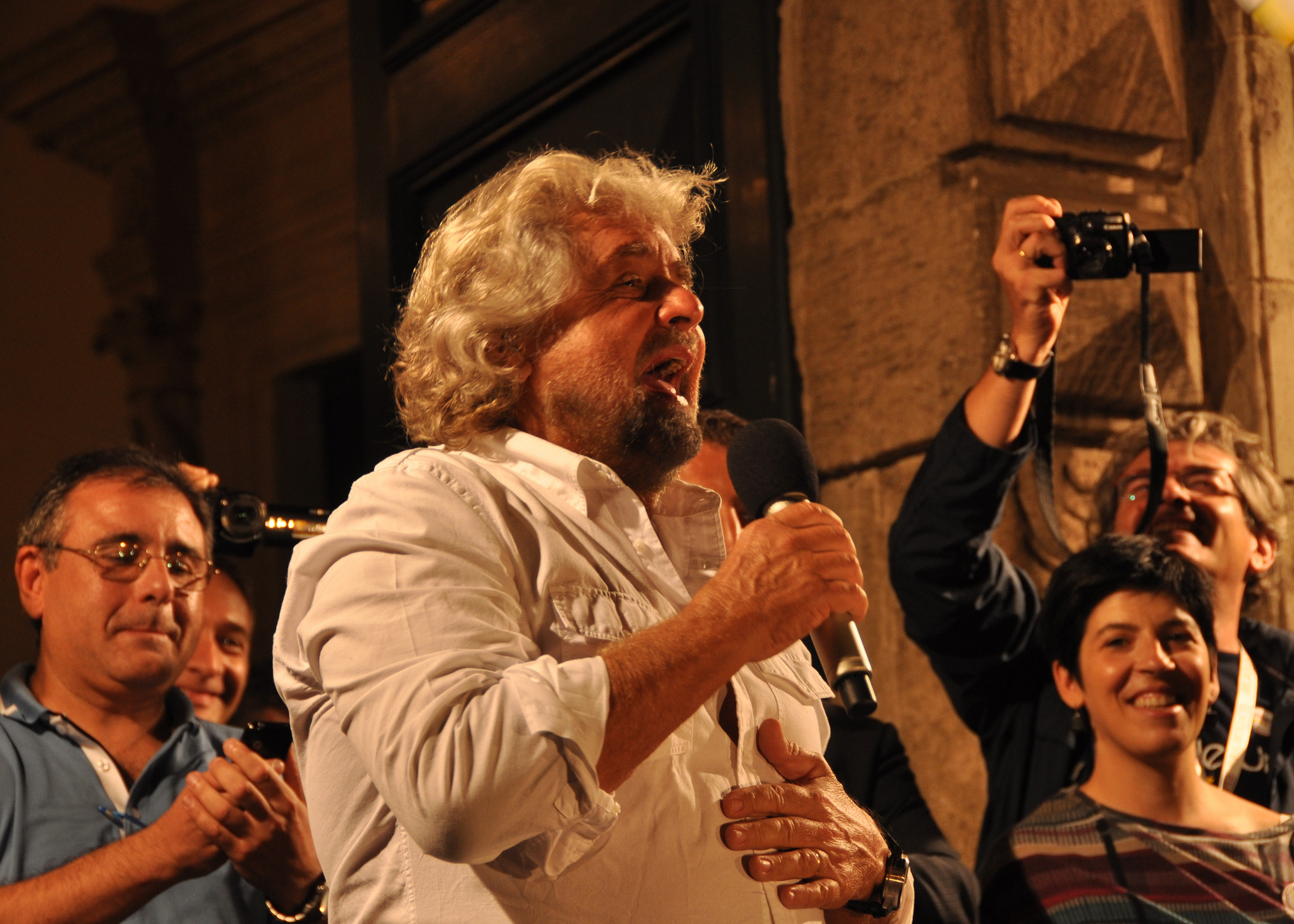
The roots and consequences of Italy’s political experiment
While we all admire its food, operas, and scenery, Italy’s political developments are often commented upon with disdain in European capitals. The country’s long tradition of supporting political mavericks – pornstar Ilona Staller in the 1980s, media tycoon Silvio Berlusconi in the 1990s and comedian Beppe Grillo in the 2000s – has frequently raised eyebrows across the West. Yet international commentaries have seldom been as alarmist as last spring, when, after a lengthy negotiation, the far-right League of Matteo Salvini and the Five Star Movement led by Luigi Di Maio joined forces to forge Western Europe’s first genuine anti-establishment government, with the previously totally unknown law professor Giuseppe Conte as prime minister. Now that this government has survived the summer, it seems time to question why rightly Italy, a country mired in tradition that has the image of slow reformer, has launched this unlikely political experiment, and what consequences this harbours for the country and the rest of Europe.
It should perhaps first be remarked that, contrary to its image, Italy has actually a long tradition of radical political experiments that preceded developments elsewhere. All these experiments were responses to the exceptionally large gap that has always existed in Italy between political elites (or, perhaps, ‘the state’) and ordinary citizens. The idea of a united Italy might have been cherished by cultural elites on-and-off since the days of Dante, but the country’s unification in the 1860s was the result not of a popular revolt, but of a series of geopolitical initiatives.
Ever since unification, Italy’s political leaders have aimed to bridge the resulting gap between elites and citizens, thereby turning Italy into a laboratory for political experiments that had repercussions far beyond its borders. Indeed, in the chaos that followed the First World War, Benito Mussolini marched on Rome and established the continent’s first fascist dictatorship. After the collapse of the fascist regime in 1945, Italy pioneered in the rise of powerful mass parties that everywhere in Europe characterized the age of postwar reconstruction. And when these traditional parties went in decline, it was again Italy that showed what a post-party future would look like: already in the early 1990s the country had its first populist government under Silvio Berlusconi’s leadership.
Tellingly, by 2018 Berlusconi has become a traditional type of politician, to the extent that European leaders let it known that they actually preferred Il Cavaliere rather than the extremist League and the unpredictable Five Star Movement to win the 2018 elections. Their preference for Berlusconi, despite his long track record of diplomatic blunders, judicial allegations, and governmental mismanagement, was emblematic of the growing despair in European capitals in the face of continuing turmoil in Rome.
However, it was most of all exemplary of the lack of understanding across Europe of the roots of the crisis which brought the current government to power. Not only was Berlusconi unable to launch a convincing political comeback (also, it should be added, because a judicial ruling impeded him to stand as candidate), but the electoral success of the League and the Five Star Movement was a consequence of the failure of his political project. Berlusconi’s populist Forza Italia has become mainstream, and, with the social-democratic Partito Democratico, embodies the old political order increasingly held responsible for at least four different, but interrelated crises.

The contours of four longstanding problems
The birth of the ‘government of change’, as the League-Five Star Movement coalition proudly calls itself, is rooted in these four long-standing problems. The first, and arguably biggest, problem, is the protracted economic crisis that Italy has experienced. Italy’s economic problems go back at least three decades and are manifold: the country has accumulated a massive public debt that threatens to become unsustainable; it has lost competitiveness because of lack of investment in research and development; it suffers from a crumbling infrastructure (tragically underlined this summer by the collapse of the highway-bridge in Genoa); and its industry is particularly vulnerable to delocalization of factories and labour to other countries.
This has grave social consequences that are often underestimated elsewhere in Europe. Pro capita income in Italy has practically stalled since the early 1990s and is still not back on pre-2008 crisis levels. Many Italians do unskilled work which earns them a mere €1000 a month. Thousands of graduates have left the country to seek a future elsewhere in Europe, causing a serious brain drain. And the economic crisis has moreover widened the already large gap between the rich north and the poor south, which has an average pro-capita income lower than Greece’s.
All this explains not only the Five Star Movement’s promise to introduce a ‘basic income’ (which is, in fact, a kind of temporary unemployment benefit that Italy still lacks) that would mainly benefit impoverished southerners, but also the League’s promise of a ‘fiscal revolution’ that ought to kickstart the sluggish northern economy and increase domestic consumption.
The second problem, at least in the eyes of a growing number of Italians, is the relationship between Rome and Brussels. While traditionally a fairly pro-European country, the economic problems have slowly eaten away Italian support for more European integration. Since the early 1990s, the country has experienced a long series of tax raises and budget cuts to meet the targets and requirements of the eurozone. One finance minister famously called upon Italians to ‘put one hand on their heart and the other one in their wallet’ to satisfy Brussels. While the question whether eurozone membership has been economically beneficial is disputed, it is certain that Italian democracy paid a price: at three moments in the last decades technocrat prime ministers were appointed to meet the country’s immediate international financial obligations.
While Europe closely monitored Italy’s attempts to reform its economy, European solidarity with Rome was absent when the country faced the arrival of hundreds of thousands of immigrants who made the perilous journey across sea from Libya. Years of diplomatic negotiations of successive Italian government with Brussels resulted only in unkept European promises to redistribute migrants: many Italians, regardless whether they are pro- or against migration, have concluded that Brussels, always ready to threaten with sanctions over lacking economic reforms, has abandoned Italy to deal with the migrant crisis alone. Salvini sensed, and exploited, the growing resentment with Brussels and promised to send illegal immigrants back to Africa – a promise he seems committed to keep in his role as Interior Minister, refusing ships carrying migrants to dock in Italian ports (including an Italian coast guard vessel).

A third main problem that explains the formation of this particular government is the lack of state efficiency, transparency and meritocracy combined with continuing political corruption. Berlusconi rose to power in the early 1990s on the waves of the major corruption scandal that wiped out the old political class of Christian democrat and socialist politicians that had ruled Italy for decades. As a successful entrepreneur, he promised to modernize the bureaucracy and end old corrupt practices. Yet in practice the Berlusconi era saw the deeper entrenchment of clientelism and corruption, which according to estimates cost the Italian economy about 60 billion euros yearly. At the same time, modernization of the bureaucracy and economy has failed: especially the young generation feel that they are battling with a system that is working against them. Merit is less appreciated than personal connections, while the country’s political class rewards itself with excellent salaries, pensions and facilities. Not without reason, one of the first demands of the Five Star Movement was for a parlamento pulito, a ‘clean parliament’, and the movement successfully rallies younger voters who want to end privileges of older generations.
The fourth problem is more political in nature, and shows how, again, Italy foreshadows developments elsewhere in the West. Like electorates elsewhere, Italians increasingly lose faith in the traditional elements of representative democracy: parties and parliament. However, because of the depth of its political crisis this, earlier than elsewhere, opened up space for political experiments that deliberately bypass parliaments and parties. The first was Berlusconi, who, through his tv-channels, directly forged ties with his electorate, never hiding his disdain for traditional party politics of professional politicians. Yet as Berlusconi’s star faded, Italians were, again earlier than elsewhere, forced to look for alternatives to the personalization of politics by means of the television. Berlusconi’s monopoly of traditional media forced the opposition to explore the opportunities of the internet to organize politically and present an alternative for the idea that one person only could interpret the will of the people. The Five Star Movement is therefore not only an alternative to the traditional political parties, but also to personalized populism. It is built on the assumption that all its adherents can contribute to the formation of its opinion, it deliberately lacks a clear leader, and it beliefs that parliamentary democracy will, eventually, be superseded and replaced with direct internet democracy.
As is clear from the above, the four main problems are interwoven: Italy’s economic problems are political and vice versa, and all touch upon Italy’s place in Europe. Yet the new government has no unified approach as how to tackle them. Rather, it is a compromise government between two political forces that are primary held together by their determination to take over from the old political class. The ‘change’ that the government says to embody, is therefore dependent on the dynamics of convergence, collaboration and conflict between these two forces. These dynamics in turn harbour important consequences for the future of Western democracy more generally.
The new government can capitalize on the virtual absence of any serious alternative in Italy itself
The Five Star Movement as most powerful player
In theory, the Five Star Movement is the most powerful player in the new government, having gained almost 33% of the votes in the last parliamentary elections of March 2018. This victory, stunning though it may seem to foreign pundits and politicians, had been long anticipated in Italy. The Five Star movement was established under the last Berlusconi government some ten years ago. Originally a primarily left-wing internet community that grew out of the blog of popular comedian Beppe Grillo, it quickly moved to the streets, where Grillo inspired hundreds of thousands of followers (also from the centre and the right) to join his big Vaffanculo (‘go fuck yourself!’) to the country’s leading class. With the help of his long-time ally, the whiz kid Gianroberto Casaleggio, Grillo’s blog transformed into an innovative online platform that allowed citizens to share their griefs and solutions for the dire state of Italian politics, economy and ecology. The movement subsequently entered the political arena and obtained a major victory already in the parliamentary elections of 2013. Having gained an air or respectability under its new leader Luigi di Maio, a young and eloquent politician from Naples, Five Star decisively won the 2018 elections with the promise to clean up Italy’s rotten political system.
This victory shows that, as an internet movement, Five Star is better equipped than any other party to attract the swing voters that characterize modern democracies. Even though participation on its online platform Rousseau is often disappointing, the movement at least in theory offers a level of civic participation unknown to other Italian parties. And Di Maio seems to personify the party’s ability to unity a broad variety of voters: he comes from a family with neofascist sympathies, but has turned to the Left. The fluid character of the movement – without a fixed ideology, voter base or leader – provides ample opportunities to attract new adherents and experiment in new types of citizen engagement.

Yet now that Five Star Movement is in government, the movement’s strengths risk to turn into liabilities. The ‘liquid’ party is time and again overshadowed by its coalition partner, the League, which seems in many respects the exact opposite of Five Star. While the Five Star Movement lacks a fixed ideology and organisation, the League has a strict hierarchy with a clear leadership and loyal base of supporters. Its leader Salvini, who is from Milan, embodies a political transformation inversely proportional to that of Di Maio: he started his political career as communist, rose to political fame as fierce protagonist of the idea of an independent Northern Italy, before dropping the antonym ‘Northern’ from his party’s name and transforming the League into a national far-right party whose main enemies are the European Union and immigrants.
Salvini might lack Di Maio’s eloquence and tailored suits, he certainly does not lack political cunning, the kind of Machiavellian furbizia that many Italians consider a virtue: by stepping up rhetoric against migrants and refusing ships to dock in Italian ports Salvini has shrewdly used the country’s continuing migrant crisis to his own political advantage. The polls speak loudly about his success: the League, which gained only 17% of the votes in the last elections, now equals the Five Star Movement in popular support. Together, both parties enjoy a fairly stable approval rate of ca. 60%.
This is a remarkably high score for a country where citizen’s trust in the institutions (and vice versa) has always been low. But it should not be taken as evidence that the ‘government of change’ has finally found a way to reduce the long-existing gap between elites and people that defines modern Italian history. On the contrary: the Five Star Movement and the League unabashedly continue their anti-establishment rhetoric even though they are now the ones in power, pretending that they are on the side of the citizens against the state. If anything, their high approval rates therefore show the continuing distrust people feel towards the traditional political system.
But the main challenge for both parties will be how to maintain their anti-establishment message while also implementing real change from above. Thus far, Salvini’s League has been most successful in this regard as well, eclipsing Five Star in scapegoating the external establishment, i.e. the European Union, for all Italy’s problems. His hard-headed handling of the migration issue not only receives much support from his voters, but also seems to succeed in convincing other European leaders to adopt a different migration policy. Moreover, the new government can capitalize on the virtual absence of any serious alternative in Italy itself: the traditional parties on centre-right and centre-left are clearly in a deep crisis and uncapable of forming a proper opposition.
While traditionally a fairly pro-European country, the economic problems have slowly eaten away Italian support for more European integration
This situation of anti-establishment forces in power and the absence of opposition means that the ‘government of change’ will likely be there to stay, against all odds. Despite the obvious tensions between and within the far-right League and the liquid Five Star Movement (tensions that are increased by Italy’s north-south dichotomy), the two parties are clearly condemned to collaborate with each other. This does not necessarily require the current government, led by Conte, to successfully complete its term: Italy has a cherished tradition of short-lived governments, and there are numerous signs that a minor political crisis can easily create a rift within the government (for example, the prominent Five Star politician Roberto Fico, who has been appointed president of the Chamber of Deputies and comes from Five Star’s left wing, is clearly sceptical of further convergence with the League). But it does mean that Italy has entered a decisively new political phase in which the traditional powers (the Partito Democratico as heir of the postwar traditional parties as well as the personal populism à la Berlusconi) gradually fade away and make place for a new equilibrium between far-right extremism and liquid internet democracy.
The contours of that equilibrium are now being explored and defined in Italy’s latest experiment. The breakthrough of the Five Star Movement shows the extent to which swing voters who have lost their trust in fossilised parties or personal leaders, can be mobilized through the promise of a different kind of political representation and participation. But it also reveals that the resulting association of voters and representatives is ill-equipped to make a clear ideological stance that goes beyond mere anti-establishment rhetoric. Lacking a clear leader, party programme or tradition, the Five Star Movement is like a chameleon which takes on the colour of its environment. For now, that environment is dominated by Salvini, who can steer the Five Star Movement to adopt the colours of the contemporary far-right.
But the crux of the Movement is that it could not only have been Salvini, but anybody on any side of the political spectrum to force Five Star to change colours. In all its hybridity, Five Star provides a flexible shell for others to exploit. Therefore, the main question that Italy will face in the coming years is whether the new model for citizen engagement created by the Five Star Movement will be resilient enough to establish a real alternative for older forms of representation that centre on parties and personalized populism, or whether it will only undermine those forms by creating a void that it cannot fill. Either way, a subsequent question is whether the far-right will be the only force profiting from this development, or whether there will also be room for new initiatives on the left.
It is this unpredictable future that, as so often in its history, reveals the crucial significance of Italy as a political laboratory for the rest of European democracies, if not the West at large. All over Europe and in the United States, traditional parties and representative institutions are losing ground. In some cases, such as France, one politician has managed to outplay the old parties and mobilize voters behind his own personal movement, not unlike Berlusconi already did in the 1990s; in others, notably the US, the traditional parties are challenged from within; and even in less extreme cases such as Germany and the Netherlands, the gradual dissolution of the traditional mass parties is all too apparent.
Italy’s political situation shows what might happen next, when mass parties as well as personal populists have left the scene to make way for a new experiment. It should not be concluded that all countries will follow the exact same route as the one Italy has entered: the specific problems Italy faces obviously cannot be extrapolated to the West at large. But it would not be the first time in modern history that Italy sets the tone of a new political development that years later is adopted elsewhere, in a more extreme version. Then as now, it would be unwise to look at Italy only for its food, opera, and scenery.
The authors have also published a book on Italian politics: Proeftuin Italië. Hoe het mooiste land van Europa de moderne politiek uitvond.







0 Reacties
Reactie toevoegen